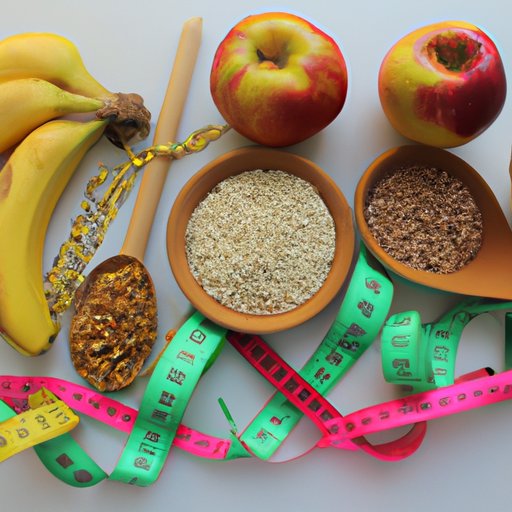
I. Introduction
Fiber is an essential nutrient that is crucial for good health. It is known for its remarkable ability to help with weight loss by keeping hunger at bay and aiding digestion. However, most people do not know much about fiber, its benefits, or the recommended daily intake. This article aims to explain the impact of fiber on weight loss, suggest ways to increase fiber intake, and provide a comprehensive list of high-fiber foods that promote weight loss.
II. The Benefits of Fiber in Weight Loss
Fiber has multiple benefits that make it an essential nutrient for weight loss. First, fiber is instrumental in digestion. It absorbs water and adds bulk to the stool, reducing the time it spends in the colon and lowering the risk of constipation. Secondly, Fiber slows the body’s digestion process, leading to feelings of fullness and reducing the urge to eat. Finally, fiber slows down the absorption of sugars into the bloodstream, reducing insulin spikes, and promoting steady weight loss.
III. How Fiber Can Help You Lose Weight
There is significant scientific evidence supporting fiber’s impact on weight loss. Several studies show that high-fiber diets lead to reductions in body weight, waist size, and body mass index (BMI). However, not all types of fiber are the same. Soluble fiber is more effective at promoting weight loss because it absorbs more water, forming a gel-like substance that slows digestion and reduces appetite. By contrast, Insoluble fiber acts as a bulking agent, promoting regular bowel movements, and controlling blood sugar.
To increase fiber intake, you can try adding high-fiber foods, such as fruits, vegetables, whole grains, and legumes. Each meal should have a healthy serving of fiber; this provides the body with adequate nutrition while helping with satiety and weight loss. You can also opt for supplement in the form of psyllium husks or glucomannan.
IV. High-Fiber Foods for Weight Loss
Here are some excellent high-fiber foods that promote weight loss:
- Whole grains (brown rice, quinoa, oatmeal)
- Fruits (apples, bananas, strawberries)
- Veggies (spinach, broccoli, carrot)
- Legumes (beans, lentils, peas)
- Nuts and seeds (chia, flax seeds, almonds, walnuts)
You can incorporate these foods into your everyday meal plan in various ways. For example, you can:
- Replace white flour with whole-grain flour in baked goods
- Add chia seeds or flax seeds to smoothies and yogurt
- Eat leafy greens salads in place of fast food meals
- Snack on nuts or carrots and hummus instead of processed snacks
High-fiber foods lead to a longer feeling of fullness which reduces overall calorie intake.
V. The Role of Fiber in a Healthy Diet
Fiber is necessary for a healthy diet, not just for weight loss. The recommended daily fiber intake varies depending on age and gender, but most adults should aim for at least 25-30 grams per day. A balanced, healthy diet is critical for obtaining the nutrients the body needs for optimal health, so trying to eat whole foods is the best possible option.
Fiber can reduce the risk of chronic diseases like heart diseases, cancer, type 2 diabetes, and stroke. It also aids digestion, helps to balance gut bacteria, strengthens the immune system, and reduces inflammation.
Some simple ways to reach the recommended daily fiber intake is to start your day with oatmeal, eat plenty of fruits and vegetables, substitute white bread and pasta with whole-grain alternatives, and opt for legumes like chickpeas and lentils over meat in meals.
VI. The Truth About Fiber and Weight Loss
Although fiber is an essential nutrient for weight loss, several myths and misconceptions surrounding its efficacy exist. One of the most common misunderstandings is that fiber is a magic weight loss solution that requires no effort or change in diet. While it is true that fiber promotes weight loss and reduces hunger, incorporating high-fiber foods into your daily diet requires a conscious effort. A well-rounded diet consisting of macronutrients, micronutrients, and fibers can play a vital role in successful weight loss.
Another common myth is that only foods high in fiber are required for weight loss. For optimal results, fibre intake should be complemented with other healthy diet habits such as reducing processed food intake, reducing sugar intake, and increasing physical activity levels. These strategies help to create a caloric deficit while providing the body with all the necessary nutrients.
VII. Conclusion
Adding fiber-rich foods to your diet is a simple yet effective way to achieve your weight loss goals. By incorporating high-fiber foods and aiming for the daily recommended amount of fiber, you can achieve sustainable weight loss while improving overall health and well-being.





